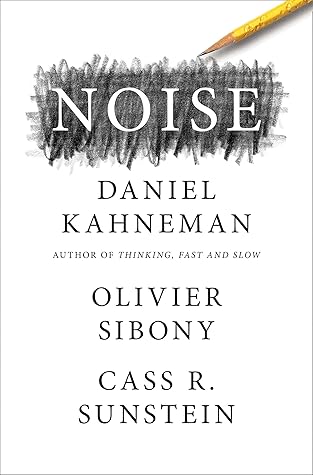More on this book
Community
Kindle Notes & Highlights
Bias and noise—systematic deviation and random scatter—are different components of error. The targets illustrate the difference.
Some judgments are biased; they are systematically off target. Other judgments are noisy, as people who are expected to agree end up at very different points around the target.
A general property of noise is that you can recognize and measure it while knowing nothing about the target or bias.
wherever there is judgment, there is noise—and more of it than you think.
law without order.
selection cannot work without variation.
System noise is a problem of systems, which are organizations, not markets.
“Remember: a singular decision is a recurrent decision that is made only once.”
Judgment can therefore be described as measurement in which the instrument is a human mind.
the most common measure of variability is standard deviation,
Focusing on the process of judgment, rather than its outcome,
System noise is inconsistency, and inconsistency damages the credibility of the system.
bias and noise are interchangeable in the error equation, and the decrease in overall error will be the same, regardless of which of the two is reduced.
there is more noise than bias.
The rule is appropriate for purely predictive judgments,
occasion noise affects all our judgments, all the time.
People who are in a good mood are more likely to let their biases affect their thinking.
you are not the same person at all times.
When physicians are under time pressure, they are apparently more inclined to choose a quick-fix solution, despite its serious downsides.
gambler’s fallacy: we tend to underestimate the likelihood that streaks will occur by chance.
popularity is self-reinforcing
independence is a prerequisite for the wisdom of crowds.
after people talk with one another, they typically end up at a more extreme point in line with their original inclinations.
replacing you with a model of you does two things: it eliminates your subtlety, and it eliminates your pattern noise.
giving up the emotional reward of the internal signal is a high price to pay when the alternative is some sort of mechanical process that does not even claim high validity.
Whatever the outcome (eviction or not), once it has happened, causal thinking makes it feel entirely explainable, indeed predictable.
process of understanding reality is backward-looking
It is the occurrence of the event that tells you its cause.
“In the valley of the normal, events are neither expected nor surprising—they just explain themselves.”
Our ability to compare cases is much better than our ability to place them on a scale.
the emotion of outrage is the primary determinant of punitive intent.
people are much more sensitive to the relative value of comparable goods than to their absolute value.
the choice of a scale can make a large difference in the amount of noise in judgments, because ambiguous scales are noisy.
replacing absolute judgments with relative ones, when feasible, is likely to reduce noise.
Noise is inherently statistical:
Experts still produce judgments, not computations.
Intelligence is correlated with good performance in virtually all domains.
the predictive power of GMA is “larger than most found in psychological research.”
cognitive reflection test
actively open-minded thinking
a good decision maker should aim to keep a “shadow of a doubt,” not to be “the man who knew too much.”
“When the facts change, I change my mind. What do you do?”)
decomposition, independent assessment on each dimension, and delayed holistic judgment
recruiters and candidates severely underestimate the noise in hiring judgments.
wherever there is judgment, there is noise, and more of it than you think.
The goal of judgment is accuracy, not individual expression.
Think statistically, and take the outside view of the case.
Structure judgments into several independent tasks.
Resist premature intuitions.
Obtain independent judgments from multiple judges, then consider aggregating those judgments.


